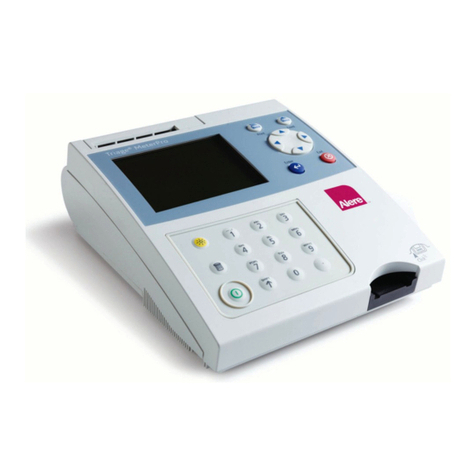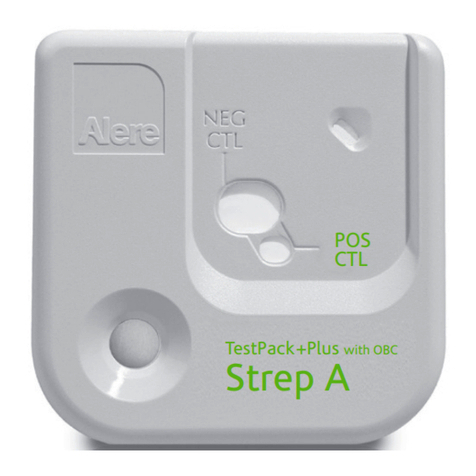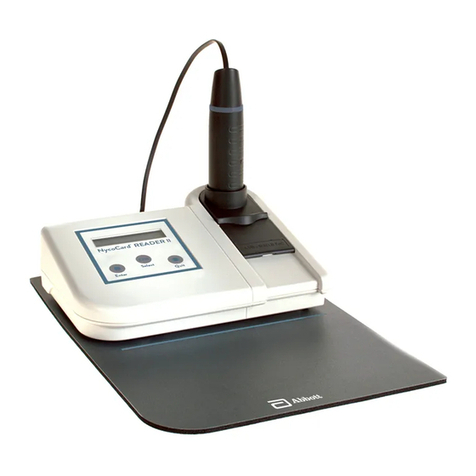
7
EN
CROSS REACTIVITY
The E. HISTOLYTICA QUIK CHEK™test was evaluated for cross-reactivity with the bacterial and viral
strains listed below. None of the strains were shown to interfere with the performance E. HISTOLYTICA
QUIK CHEK™test.
Aeromonas hydrophila
Bacillus cereus
Bacillus subtilis
Bacteroides fragilis
Campylobacter coli
Campylobacter fetus
Campylobacter jejuni
Candida albicans
Clostridium bifermentans
Clostridium difcile
Enterococcus faecalis
Escherichia coli
Escherichia coli O157:H7
Escherichia coli EIEC
Escherichia coli EPEC
Escherichia coli ETEC
Klebsiella pneumoniae
Salmonella typhimurium
Shigella dysenteriae
Shigella exneri
Shigella sonnei
Staphylococcus aureus
Staphylococcus aureus (Cowan’s)
Staphylococcus epidermidis
Vibrio parahaemolyticus
Yersinia enterocolitica
Adenovirus, 2, 5, 40, 41
Coxsackievirus B5
Echovirus 11, 18, 22, 33
Enterovirus 68, 69
Human Adenovirus 1, 3
Human Coronavirus
Human Coxsackievirus B2, B3, B4
Human Echovirus 9
Human Enterovirus 69, 70, 71
Human parechovirus 1
[Echovirus 22]
Human Rotavirus
Cross reactivity with Norovirus is unknown because it was not tested in analytical studies. However,
Norovirus GI/GII was identied in 50 clinical specimens using an FDA cleared multiplex NAAT assay
during clinical testing and no cross reactivity was found using the E. HISTOLYTICA QUIK CHEK™in
those samples.
Additionally, the E. HISTOLYTICA QUIK CHEK™test was run on fecal specimens documented to
be positive for other parasites by microscopy. The number in parenthesis is the number of clinical
specimens in which each organism was identied. No cross-reactivity was seen with the following
organisms.
Ascaris lumbricoides and
with eggs (21)
Blastocystis hominis (12)
Cryptosporidium spp. (30)
Entamoeba bangladeshi (3)
Entamoeba coli (13)
Entamoeba moshkovskii (3)
Giardia spp. (45)
Iodamoeba bütschlii (10)
Trichuris trichiura eggs (11)
STRAIN SPECIFIC STUDY
The specicity of the E. HISTOLYTICA QUIK CHEK™test was also evaluated by examining the reactivity
of pathogenic (Entamoeba histolytica) and non-pathogenic (Entamoeba dispar) zymodemes (strains) for
reactivity by standard curve dilutions. E. histolytica results were positive from 244 to 30.5 pathogenic
zymodemes (PZs)/mL and the E. dispar results were negative at all dilutions beginning at 2440 non-
pathogenic zymodemes (NPZs)/mL. The E. HISTOLYTICA QUIK CHEK™test demonstrates proper
reactivity with Entamoeba histolytica and does not cross-react with Entamoeba dispar.
Additionally, due to the similarity in morphology, 3 specimens identied by PCR as positive for Entamoeba
moshkovskii and 3 postive for Entamoeba bangladeshi were evaluated using the E. HISTOLYTICA QUIK
CHEK™test. These 6 specimens all tested negative in the E. HISTOLYTICA QUIK CHEK™test.
INTERFERING SUBSTANCES (U.S. FORMULATION)
The following substances had no effect on positive or negative test results analyzed at the concentrations
indicated: Barium sulfate (5% w/v), Benzalkonium Chloride (1% w/v), Ciprooxacin (0.25% w/v), Ethanol
(1% w/v), Hog gastric mucin (3.5% w/v), Human blood (40% v/v), Hydrocortisone (1% w/v), Imodium®
(5% v/v), Kaopectate®(5% v/v), Leukocytes (0.05% w/v), Maalox®Advanced (5% v/v), Mesalazine
(10% w/v), Metronidazole (0.25% w/v), Mineral Oil (10% w/v), Mylanta®(4.2 mg/mL), Naproxen Sodium
(5% w/v), Nonoxynol-9 (40% w/v), Nystatin (1% w/v), Palmitic Acid/Fecal Fat (40% w/v), Pepto-Bismol®
(5% v/v), Phenylephrine (1% w/v), Polyethylene glycol 3350 (10% w/v ), Prilosec OTC®(5 µg/mL),
Sennosides (1% w/v), Simethicone (10% w/v), Steric Acid/Fecal Fat (40% w/v), Tagamet®(5 µg/mL),
TUMS (50 µg/mL), Human Urine (5% v/v), and Vancomycin (0.25% w/v).
PRECISION – INTRA-ASSAY
For the determination of intra-assay performance, twelve human fecal specimens were analyzed by
the E. HISTOLYTICA QUIK CHEK™test. Of these twelve specimens, six were positive for E. histolytica
of varying levels (low, moderate, and high) and six were negative for E. histolytica. Each specimen was
assayed ve times in the same test run, using two different kit lots. A positive and negative control was
run with each panel. All positive samples remained positive and all negative samples remained negative.
The overall correlation between the results was 100%.
PRECISION – INTER-ASSAY
For the determination of inter-assay performance, eight human fecal specimens were analyzed by the
E. HISTOLYTICA QUIK CHEK™test. The samples included 2 negative samples, 2 high negative samples,
2 low positive samples and 2 moderate positive samples. The samples were tested, twice a day by
multiple technicians over a 12-day period using 2 different kit lots. A positive and negative control was
run on each day. All positive samples remained positive and all negative samples remained negative.
ANALYTICAL SENSITIVITY
The Limit of Detection (LoD) for the E. HISTOLYTICA QUIK CHEK™test was established at 320
pathogenic zymodemes (PZs)/mL for E. histolytica (equivalent to 15 PZs detected per test). For
specimens in Protocol™Cary Blair media, the LoD was established at 275 PZs/mL for E. histolytica
(equivalent to 14 PZs detected per test). For specimens in Para-Pak®C&S media, the LoD was
established at 245 PZs/mL for E. histolytica (equivalent to 12 PZs detected per test).
FRESH VERSUS FROZEN SAMPLES
The effect of long term frozen specimen storage on antigen stability was evaluated. For the analysis,
a total of 15 fecal specimens were tested with the E. HISTOLYTICA QUIK CHEK™test. The fecal
specimens consisted of 3 negative fecal samples, 3 E. histolytica high negative fecal samples,
3 E. histolytica low positive fecal samples, 3 E. histolytica moderate positive fecal samples, and
3 E. histolytica high positive fecal samples. Samples were prepared and stored ≤ -10°C at 0, 1, and 4, 8,
12, 16, 20, 24 and 28 weeks. No conversion of positive-to-negative or negative-to-positive was observed
in any of the samples at the specied time points.
PROZONE
To ensure that a high concentration of E. histolytica antigen does not interfere with a positive reaction in
the E. HISTOLYTICA QUIK CHEK™test, high samples were prepared by spiking a negative fecal pool
at a concentration possibly observed in clinical specimens. A total of 5 different dilutions of the antigen,
up to and including the clinically observed high concentration, were prepared and tested in triplicate.
The results demonstrated that there was no overall prozone affect, that elevated levels of antigen did not
affect the detection of the antigen.
FOR INFORMATIONAL USE
ONLY






























